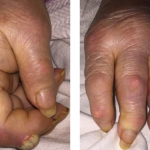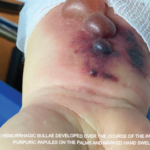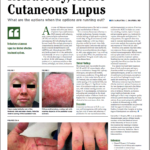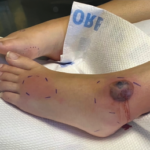Management of Staphylococcal scalded syndrome includes appropriate antibacterial coverage and intravenous hydration. Given the syndrome’s rarity and severity, this case emphasizes the importance of considering Staphylococcal scalded syndrome in the differential diagnosis of bullous lesions in a patient with SLE.
Mitali Sen, MD, is a second-year internal medicine resident at Albert Einstein Medical Center in Philadelphia.
Corrado Minimo, MD, is the attending physician in the Department of Pathology at Albert Einstein Medical Center in Philadelphia.
Ruchika Patel, MD, is the attending physician in the Department of Rheumatology at Albert Einstein Medical Center in Philadelphia.
References
- Crowson A, Magro C. The cutaneous pathology of lupus erythrematosus: A review. J Cutan Pathol. 2001 Jan;28(1):1–23.
- Rothfield N, Sontheimer R, Bernstein M, et al. Lupus erythrematosus: Systemic and cutaneous manifestations. Clin Dermatol. 2006 Sep–Oct;24(5):348–362.
- Yell JA, Mbuagbaw J, Burge SM. Cutaneous manifestations of systemic lupus erythrematosus. Br J Dermatol. 1996 Sep;135(3):355–362.
- Duan L, Chen L, Zhong S, et al. Treatment of bullous systemic lupus erythematosus. J Immunol Res. 2015;2015:167064.
- Contestable J, Edgehard K, Meyerle J, et al. Bullous systemic lupus erythrematosus: A review and update to diagnosis and treatment. Am J Clin Dermatol. 2014 Dec;15(6):517–524. doi:10.1007/s40257-014-0098-0.
- Merklen-Djafri C, Bessis D, Frances C, et al. Blisters and loss of epidermis in patients with lupus erythematosus: A clinico-pathological study of 22 patients. Medicine (Baltimore). 2015 Nov;94(46):e2102.
- Gladman DD, Hussain F, Ibañez D, et al. The nature and outcome of infection in systemic lupus erythematosus. Lupus. 2002;11(4):234–239.
- Gresham HD, Ray CJ, O’Sullivan FX. Defective neutrophil function in the autoimmune mouse strain MRL/lpr. Potential role of transforming growth factor-beta. J Immunol. 1991 Jun 1;146(11):3911–3921.
- Caver TE, O’Sullivan FX, Gold LI, et al. Intracellular demonstration of active TGFbeta1 in B cells and plasma cells of autoimmune mice. IgG-bound TGFbeta1 suppresses neutrophil function and host defense against Staphylococcus aureus infection. J Clin Invest. 1996 Dec 1;98(11):2496–2506.
- Patel GK, Finlay AY. Staphylococcal scalded skin syndrome: Diagnosis and management. Am J Clin Dermatol. 2003;4(3):165–175.
- Patel GK. Treatment of staphylococcal scalded skin syndrome. Expert Rev Anti Infect Ther. 2004 Aug;2(4):575–587.
- Rydzewska-Rosolowska A, Brzosko S, Borawski J, et al. Staphylococcal scalded skin syndrome in the course of lupus nephritis. Nephrology (Carlton). 2008 Jun;13(3):265–266.
- Huseyin TS, Maynard JP, Leach RD. Toxic shock syndrome in a patient with breast cancer and systemic lupus erythematosus. Eur J Surg Oncol. 2001 Apr;27(3):330–331.
- Kadoya A, Iikuni Y, Hosaka S, et al. A SLE case with toxic shock syndrome after delivery. Kansenshogaku Zasshi. 1996 Dec;70(12):1279–1783.
Acknowledgments
The authors acknowledge the assistance of the following in the preparation of this article: Sandra Schwarcz, DO, and Jose Nitram-Aliling, MD, fellows in the Department of Rheumatology at Albert Einstein Medical Center, Philadelphia. The pictures were produced with the patient’s permission, and they thank her for allowing the same.



